Author: EVAI
Toyota no longer most reliable brand, says Consumer Reports
 Subaru ranks as the most reliable brand for the first time in Consumer Reports’ annual ratings Toyota fell due to new powertrains in new vehicles Rivian ranked last in reliability, though 15 other brands weren’t rated at all Toyota or its luxury brand Lexus no longer top the most reliable brand rankings, according to an annual report published…
Subaru ranks as the most reliable brand for the first time in Consumer Reports’ annual ratings Toyota fell due to new powertrains in new vehicles Rivian ranked last in reliability, though 15 other brands weren’t rated at all Toyota or its luxury brand Lexus no longer top the most reliable brand rankings, according to an annual report published…

Nissan Ariya getting Tesla Supercharger access Dec. 10
Nissan Ariya owners will be able to charge their electric vehicles at Tesla Supercharger stations starting Dec. 10, the automaker announced Wednesday.
Nissan plans to fit new EVs sold in the U.S. with North American Charging Standard (NACS) ports starting in 2025, but existing vehicles will be able to charge at Supercharger stations using a $235 adapter, which is available to order now, Nissan said.
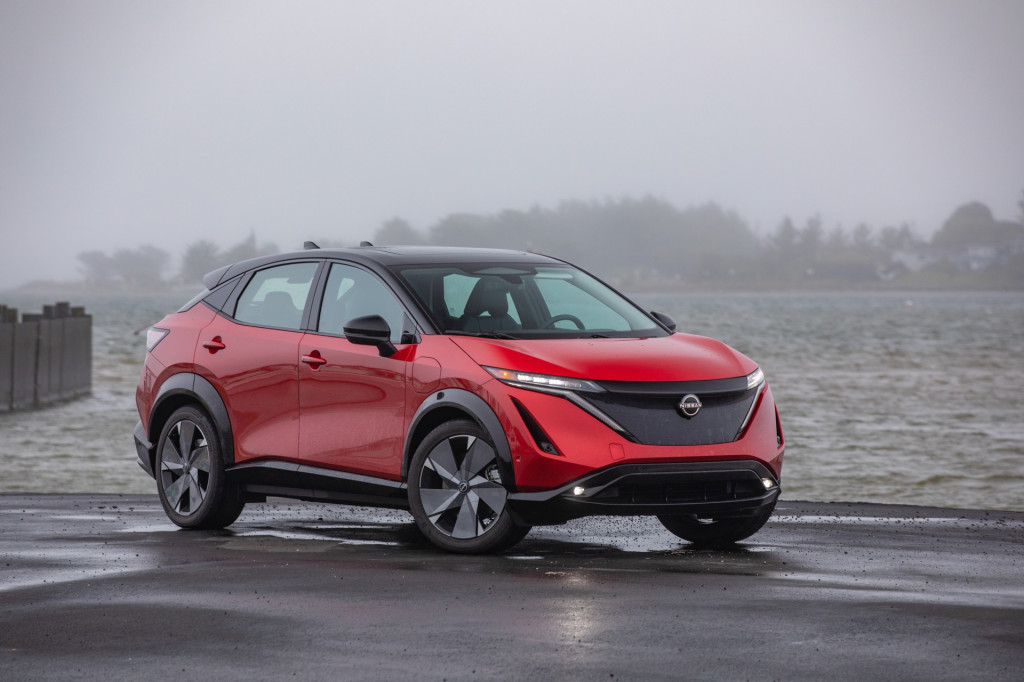
2023 Nissan Ariya e-4orce
Most major EV brands now plan to adopt the NACS port, while providing adapters to owners of existing EVs. Ford initially offered free adapters, but most other automakers that have begun offering Supercharger access, including General Motors, Kia, Polestar, and Volvo, are making customers pay for them.
Sign up for Newsletter
Nissan said 17,800 Supercharger sites will be incorporated into its Nissan Energy Charging Network interface, which offers real-time charger availability status and payment through the MyNissan app. The same features are also available for chargers on the Electrify America, Shell Recharge, EVgo, and ChargePoint networks in the U.S.
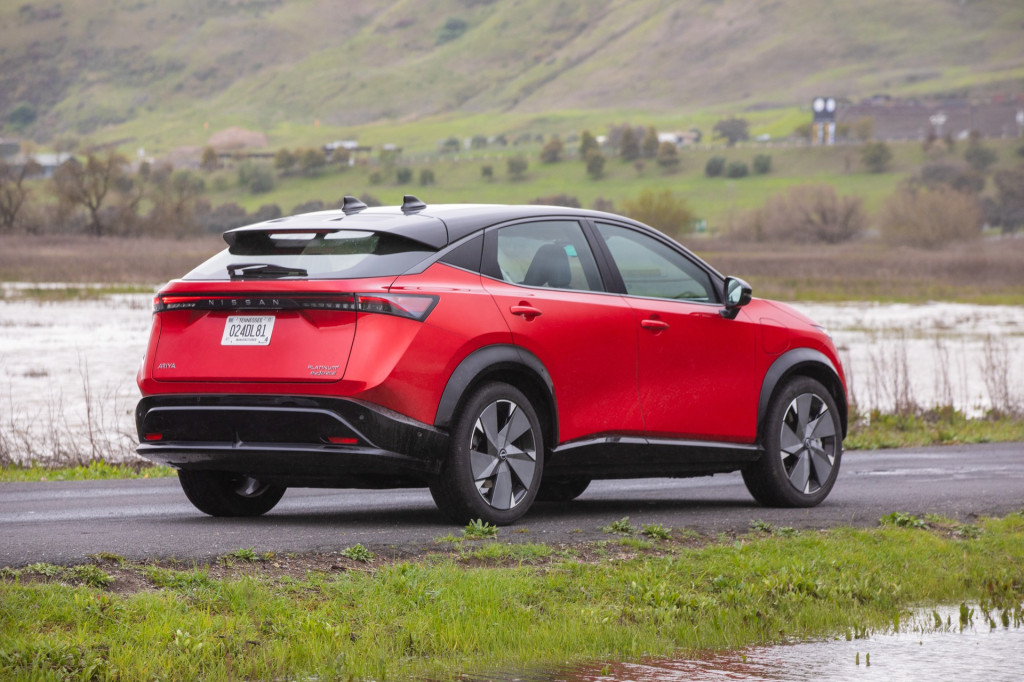
2023 Nissan Ariya e-4orce
All of this capability is available only on the Ariya, which has a Combined Charging Standard (CCS) port like most other new EVs. Nissan does not plan to offer NACS adapters for the Leaf, the last EV on sale using the CHAdeMO port. Nissan has confirmed that the Leaf will continue for the 2025 model year, but it’s likely to be replaced soon by a more crossover-like sequel with a NACS port.
The Ariya, meanwhile, was a Green Car Reports Best Car To Buy 2024 finalist thanks to its quiet interior, comfortable ride, nimble handling, and an interface that got things right straight away instead of leaning on future software updates. It arrived as a 2023 model and received price cuts of up to $6,000 for 2024.

Rivian opens Adventure Network to all EVs in Joshua Tree
From the beginning, Rivian intended its charging network to be at least partly publicly accessible. Now it’s ready to open its Adventure Network DC fast-charging sites to electric vehicles from other brands.
This will be the case with what Rivian calls its next-generation Adventure Network sites, the first of which opened Thursday in Joshua Tree, California. Rivian said that it expects to open additional locations in Texas, Colorado, Illinois, Montana, Pennsylvania, Michigan, and New York in the coming year.

Rivian Adventure Network charging site in Joshua Tree, California
These sites will offer DC fast charging at up to 900 volts, with Combined Charging Standard (CCS) connectors initially. Vehicles with Tesla-style North American Charging Standard (NACS) will also be able to charge via adapters, Rivian said, with built-in NACS connectors coming as part of a future update as Rivian moves to adopt NACS for its EVs as well.
Sign up for Newsletter
Rivian also noted that these new chargers “meet the design and siting requirements to be eligible for relevant state and infrastructure funding.” The automaker expects government funding to help pay for further expansion of the network, which it sees as “an important source of revenue” going forward.
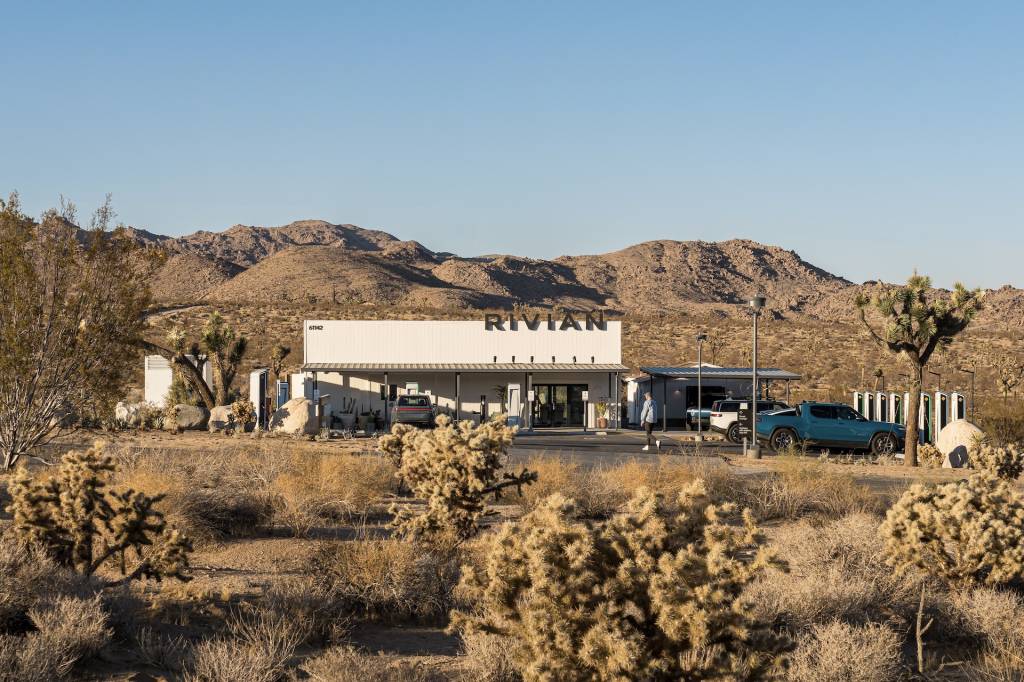
Rivian Adventure Network charging site in Joshua Tree, California
New chargers will also have larger displays and a tap-to-pay option, allowing for use with or without Rivian’s mobile app. The automaker said it will employ “100% renewable energy matching” to ensure a lower overall carbon footprint for EVs charged on its network.
Rivian started deploying its first Adventure Network chargers in 2022 as part of a “two-tier” strategy alongside Waypoint Level 2 AC destination chargers. In keeping with the automaker’s brand image, the network has been planned as a backcountry counterpart to the Tesla Supercharger network, with chargers primarily located near recreational sites.

Could a 2-speed help boost efficiency in future Lucid EVs?
- New layout for a 2-speed might be light and compact while maintaining efficiency
- Could potentially allow strong launch with a lower-cost motor unit
- Idea might be due in future Lucid EVs, or engineers might still be pondering it
The Lucid Air electric sedan already achieves impressive efficiency with its existing drive unit, but the automaker might be considering a 2-speed transmission for possible future use, a patent filing indicates.
The patent, first spotted by Motor1, was filed in 2023 and looks to build on the current drive-unit setup, which uses two coaxial planetary gearsets to provide the necessary reduction from motor speed to wheel speed while keeping packaging compact.
It describes the use of one or more planetary gearsets to achieve two gear ratios, with a tapered gear surface on each respective gear plus a system of one-way clutches to switch between them.
Most electric cars do without multi-speed transmissions, but they’ve been a topic of discussion for some time. The original Tesla Roadster was supposed to use a 2-speed gearbox, but that was substituted for a fixed reduction-gear setup after prototypes failed to handle the motor’s copious torque.
Sign up for Newsletter
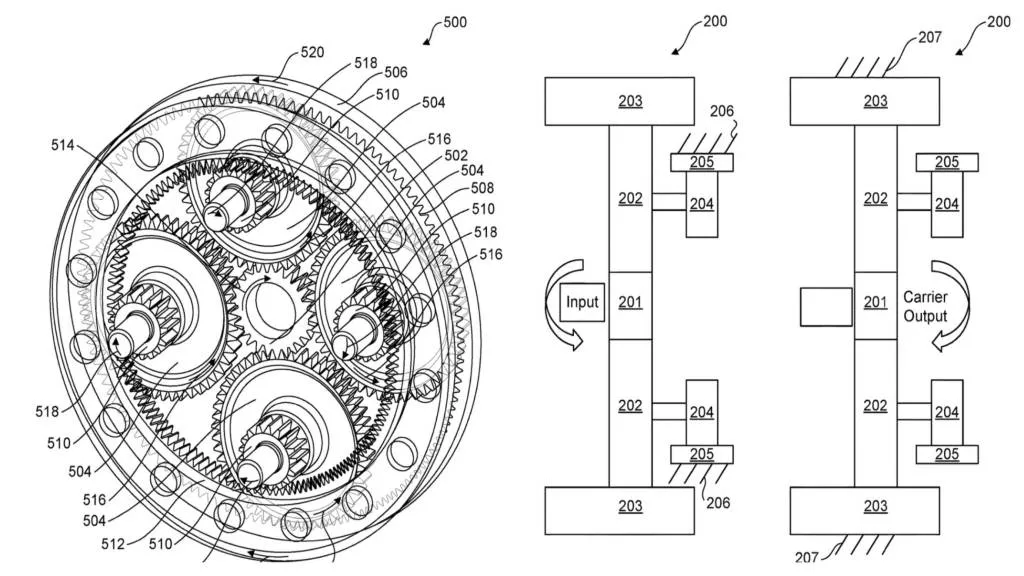
Lucid 2-speed transmission. – U.S. patent
Lucid, in the patent application, somewhat parallels explanations provided to Green Car Reports in the past from CEO and CTO Peter Rawlinson about why it hasn’t yet used a multi-speed unit. In the filing, the company’s authors explained that the gearboxes already used in a few electric-vehicle models “are complex mechanisms that take up significant space, they may have low efficiency and/or deliver low initial torque, and they place a significant inertia load on the drivetrain (e.g., an excessive jerk when shifting).”
If such a component doesn’t take up initial space or reduce efficiency, while allowing smaller, lighter motors, incorporating them with Lucid’s upcoming Atlas drive unit could pay off in averted cost and weight—although the company has made no claims as of yet that this patent has anything to do with Atlas.
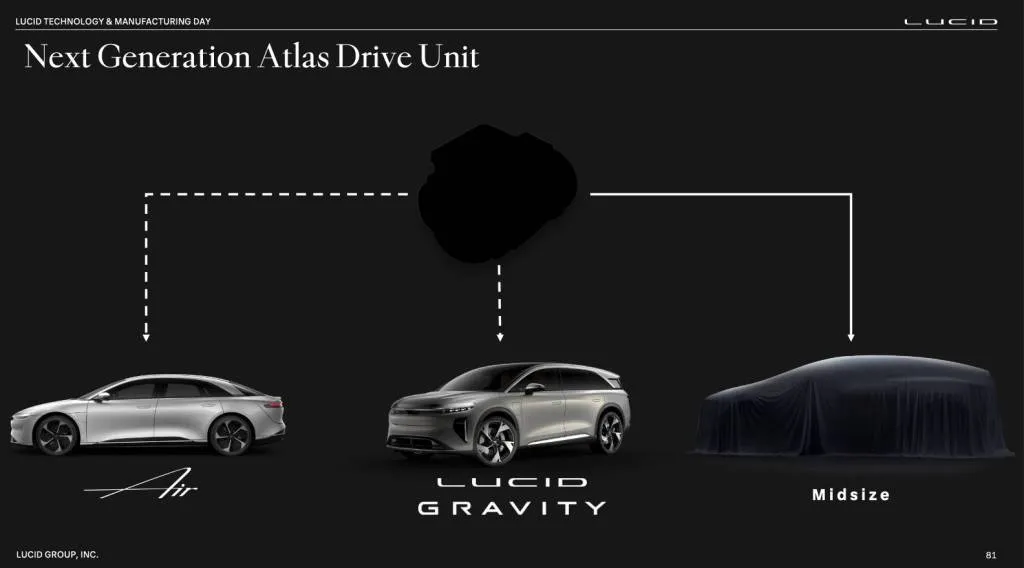
Next-generation Lucid Atlas drive unit – bound first for future midsize EVs
“Lucid continuously explores new ideas and develops technological innovations that could further advance our electric vehicle technology and help accelerate humanity’s transition to sustainable transportation and energy,” the company stated, in response to Green Car Reports’ question as to whether this patent might be connected to Atlas and thus its future midsize models, initially. “Protecting unique IP is a typical part of the innovation and development process, though we can’t speak to potential future applications of specific patents.”
Sign up for Newsletter
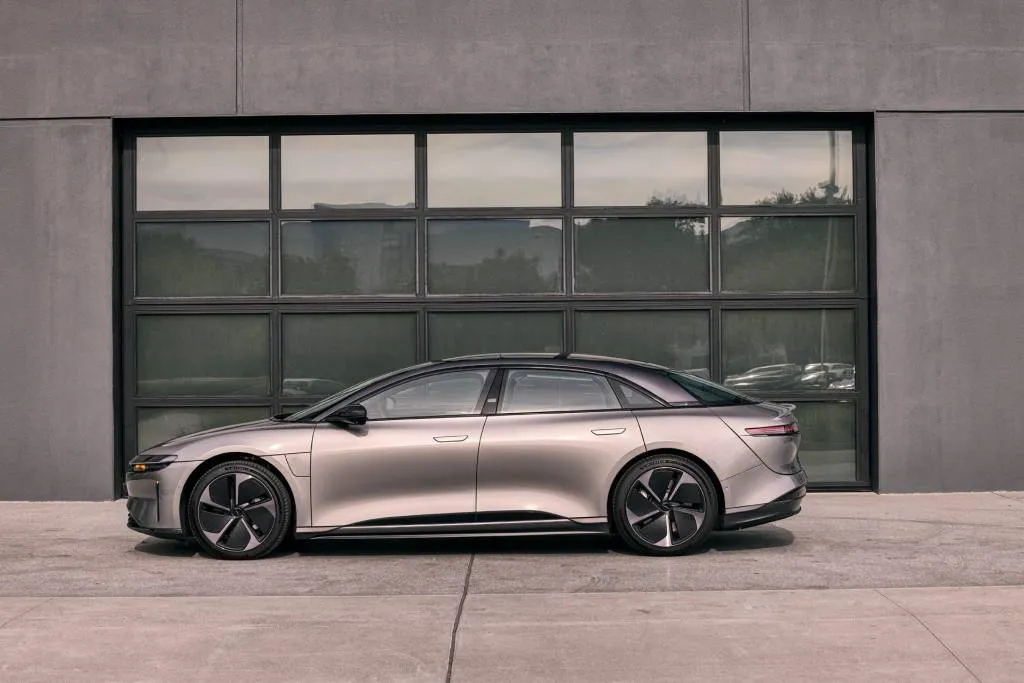
2024 Lucid Air
The Porsche Taycan has a 2-speed gearbox for its rear wheels, which Porsche has said helps balance acceleration and high-speed efficiency. The gearbox has a low gear that helps deliver more torque from a standing start, while keeping the rear motor and power electronics cooler. The high gear automatically engages at a certain speed threshold, or when the drive eases up on the accelerator (manual shifting isn’t possible), and driving it gently can skip the low ratio entirely.
In dual-motor versions of the Model S, Tesla has used motors with different gearing to achieve similar goals. Volkswagen is also confident that it can find other ways to maximize efficiency. In a recent interview with Green Car Reports, Kai Grünitz, VW’s head of global research and development, said the automaker still has no plans for 2-speed transmissions in EVs.
Mercedes-Benz, on the other hand, is using a 2-speed transmission in its next-generation MMA platform, which will underpin four compact models starting with the 2026 Mercedes CLA, which will be sold with all-electric and hybrid powertrains. And perhaps Lucid will follow through and include an additional gear ratio in some of its future EVs as well.
–with reporting by Bengt Halvorson

2026 BMW iX bridges the Neue Klasse EV current
- Refreshed iX electric crossover gets 10% more efficient
- 2026 iX will have three new model designations
- BMW refined the suspension tuning
If you’ve been following EVs, then BMW’s Neue Klasse (noo-ay class-eh) should sound familiar. Even though the “new class” sounds as French as it does German to this anglophone, BMW uses it to classify its generation of electric vehicles that launches with the iX3 crossover later this year, followed by an iteration of the 3-Series sedan.
Meanwhile, the refreshed 2026 BMW iX makes a half-step to this new class of EVs. Launched in 2022, BMW’s electric crossover arrives with significant improvements to its battery packs, propulsion systems, and other internals, though much of what we know we can’t say until late January for its global reveal.
In a brief drive outside of BMW’s Spartanburg, South Carolina, factory, the new iX rode with more comfort and seemed to have a greater range between its firm sport and soft comfort settings. There appeared to be changes to its polarizing exterior design that bridged the quirky eco-style of the discontinued i3 hatch with some of the more bold if not brash styling elements of BMW’s crossover SUVs.
It was covered in camo and the interior dash and panels were covered in the kind of thin carpet you’d find in a cargo floor. Our impressions were limited to a 15-minute test drive, and many of the mechanical details are in another kind of camouflage from BMW. Here’s what we know and what’s been leaked, and what we might expect for this iteration of the iX.
Sign up for Newsletter
Spartanburg is BMW’s largest factory in the world, and while it makes the X3 and nearly every larger crossover SUV that BMW ships to the world, the iX will continue to be made in Plant Dingolfing, in Lower Bavaria, Germany.
The 2026 iX arrives in the second quarter of 2025 with a reported three models to choose from, each representing a different performance level, in the BMW way.
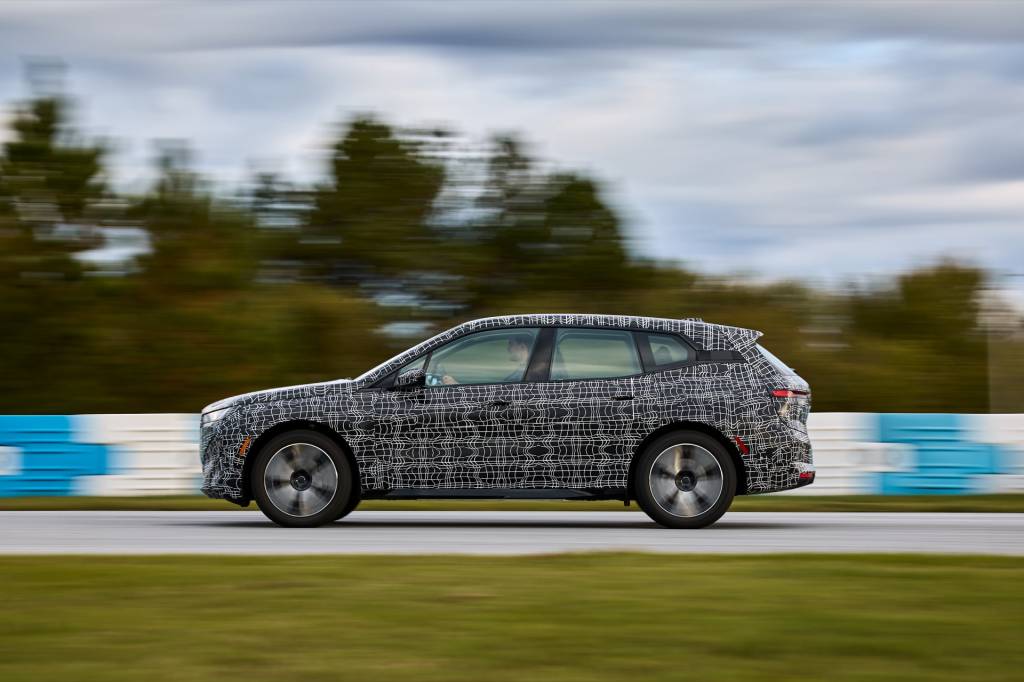
2026 BMW iX battery and motor unit improvements
All three models will have dual-motor all-wheel drive, but the new base model will be the iX xDrive45, instead of the 40, according to a leaked Bimmerpost cited by several automotive outlets. Based on EPA listings, the entry point to the 2025 BMW iX will be the xDrive40 that hasn’t been offered in the U.S. yet; it has a 71-kwh battery pack (usable) and a max range of 219 miles, according to the EPA.
Expect a larger pack and increased range at the entry point of the 2026 iX xDrive45.
Sign up for Newsletter
It’s rumored that this year’s iX xDrive50 morphs into the iX xDrive60 in 2026, and this year’s M60 becomes the M70 in 2026. It’s expected to have a larger battery pack than the existing 105.2-kwh battery pack, but it will probably stick with the prismatic cells instead of switching over to more energy-dense cylindrical cells that will underpin the Neue Klasse generation of electric vehicles. Consider this the fifth-and-a-half—not sixth—generation of BMW’s EV battery and propulsion system.
Neue Klasse vehicles will utilize an 800-volt architecture, but the iX will keep its 400-volt architecture, albeit with efficiency improvements to increase charging times. How much we don’t know. On a DC fast charger maxing out at 195 kw, the 2025 BMW iX could charge from 10-80% in 40 minutes.
Like the Neue Klasse vehicles, however, the 2026 BMW iX may use silicon anodes instead of graphite in the cells, resulting in greater energy density and faster charging speeds. More density means more energy stored, so it should translate to greater range, though that hasn’t been confirmed by BMW and likely won’t be certified by the EPA until early next year.
Other improvements to boost range include new “friction-optimized” wheel bearings, according to BMW, and more efficient headlights that consume less energy. New inverter technology increases the drive power energy for more burst, and the transfer of energy from the battery to the motor is more dense and efficient.
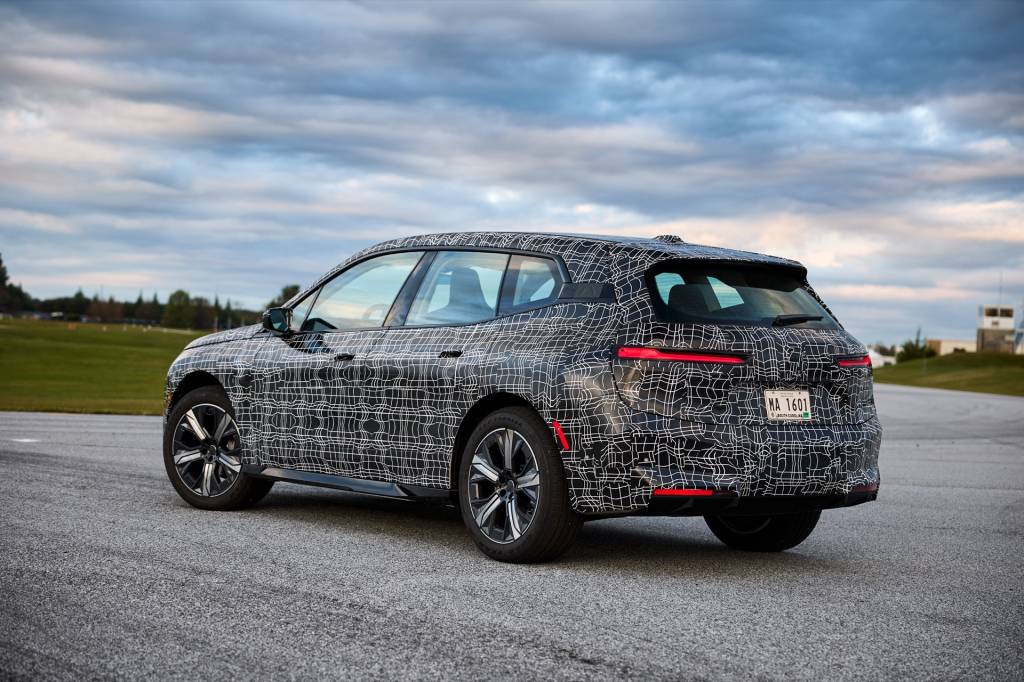
Sign up for Newsletter
2026 BMW iX estimated with 10% more efficiency
The 2025 iX xDrive50 has an EPA-rated range of 309 miles when equipped with 20-inch wheels. BMW cited a 10% increase in efficiency for the new model, so that could boost the range to 340 miles for the 2026 BMW xDrive60, when equipped with the most fuel-efficient wheels wrapped in low-rolling resistance tires.
The 2025 M60 tops out at 285 miles, while the 2026 M70 could get somewhere in the 310- to 315-mile range, based on my crude calculation. It’s much harder to speculate on the xDrive45 because BMW wouldn’t release the battery size.
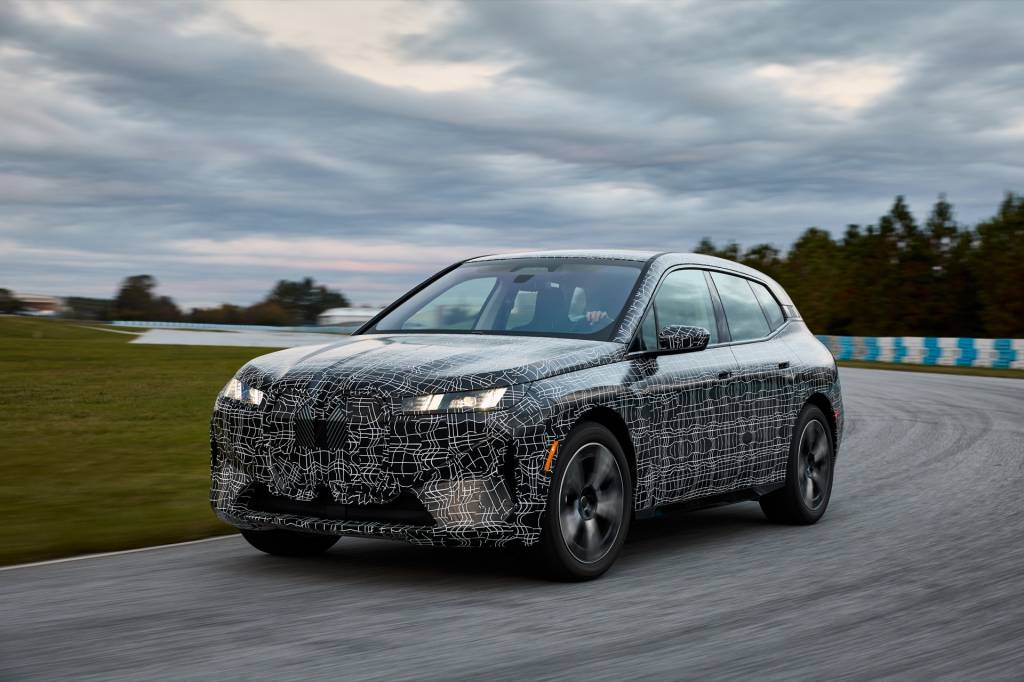
How the 2026 BMW iX drives
We don’t know if the M70 will improve on the 2025 M60’s 610-hp, 749 lb-ft of torque output and 0-60 mph time of 3.6 second, or if the iX xDrive60 will improve on the 2025 xDrive50’s 516 hp, 564 lb-ft and its 0-60 mph time of 4.4 seconds.
In my brief drive, the iX xDrive60 had gobs of power off the line, and slight toe-taps opened up bursts of acceleration at speed. It was quick enough to slap a grin on my face, but not so stark as to upset unsuspecting passengers. Eco mode predictably mushed the throttle response. Sport mode mostly deactivated the stability control system to allow for some kind of drifting, I was told, but I didn’t have the space or lack of passengers to test it. The B mode in the shifter remains for max regenerative braking that brings the iX nearly to a stop without the brake pedal. The brakes remain the same.
The 2024 iX xDrive50 I tested last year had wobbly handling and prodigious weight, making it something of an outlier in BMW’s electroverse, but BMW has worked to improve that across the iX range. I tested the iX xDrive60 with the steel-spring suspension. BMW retuned the hydraulic dampers for a calmer ride while cruising, and on the stretch of state highway I tested at about 70 mph, it made good on that promise. With the exception of the expected tire noise endemic to EVs, it was notably quiet in the cabin, even with the prototype seemingly unfinished.
The lack of steering feel in Sport mode was one of our editor’s complaints about the 2023 BMW iX. Improvements to the steering have also been made, with a more pronounced feeling between sport and comfort settings, according to BMW, but I didn’t have enough space to test that out.
The M70, like the M60 before it, will likely have a two-axle air suspension with adaptive dampers. It appears that the iron butterfly grille—one of the gaudiest takes on the kidney grille this side of the i4 electric sedan—carries over, as does the alleged self-healing grille that erases or at least blends in scratches.
New this year is an M Sport package, as requested by customers. The cosmetic Sport package on the 2025 xDrive50 might not have had enough M. It comes with blue brake calipers, whereas the M Sport Package Pro standard on the M70 gets red calipers. Maybe it’ll make M posers see red.
On the inside, the package means new M power seats with more side bolstering and a longer seat bottom by nearly two inches. Leather upholstery remains an option with the M Sport Package, but it comes with a leather-wrapped steering wheel, M pedals, and M badging.
Standard features across the lineup include adaptive cruise control up to 85 mph, welcome lighting, heated front seats and a heated steering wheel, as well as a Harman Kardon sound system.
Options include a glass roof, automatic soft-close doors, and the latest in BMW’s iDrive operating system integrated into a digital instrument cluster and touchscreen of undisclosed size. Driver-assist options include a limited hands-free driving system with automatic lane changes and a remote parking system.
The 2026 iX adds some newness to this class of BMW electric vehicle, but what future will it hold in the Neue Klasse school? We’ll find out more late in January.
BMW paid for airfare and lodging for Green Car Reports to attend its brand overview.
Recaro Automotive saved from bankruptcy by Proma Group
 Recaro Automotive is a major supplier of car seats, particularly for performance applications. However, the German company ran into hard times earlier this year, including filing for bankruptcy protection in July. Fast forward to today, and a new investor has stepped in and plans to take control of the company. As first reported by Piston Heads on…
Recaro Automotive is a major supplier of car seats, particularly for performance applications. However, the German company ran into hard times earlier this year, including filing for bankruptcy protection in July. Fast forward to today, and a new investor has stepped in and plans to take control of the company. As first reported by Piston Heads on…

Mercedes-Benz gives Pope Francis the first electric Popemobile
- The Mercedes G 580 with EQ Technology is the first electric Popemobile
- Fisker was supposed to supply an Ocean as the first electric Popemobile
- While the electric G-Class is the first electric Popemobile, it’s not the first EV in the Vatican’s fleet
Mercedes-Benz G-Class Popemobiles have been a fixture of the Vatican vehicle fleet for decades, so with the off-roader now going electric, it’s fitting that the latest Popemobile is doing the same.
Mercedes on Wednesday presented Pope Francis with the first official electric Popemobile, based on the all-electric G 580 with EQ Technology that also reaches U.S. showrooms this year as a 2025 model.
As Mercedes points out, the automaker has a long history supplying cars to the Vatican, starting with a Nürburg 460 Pullman sedan for Pope Pius XI in 1930. The term Popemobile was coined for a series of modified G-Class SUVs, starting with a 460-series model first used by John Paul II in the 1980s and also used by his successors Benedict XVI and Francis, with elevated seating platforms and armored glass enclosures for the pontiff.
Sign up for Newsletter
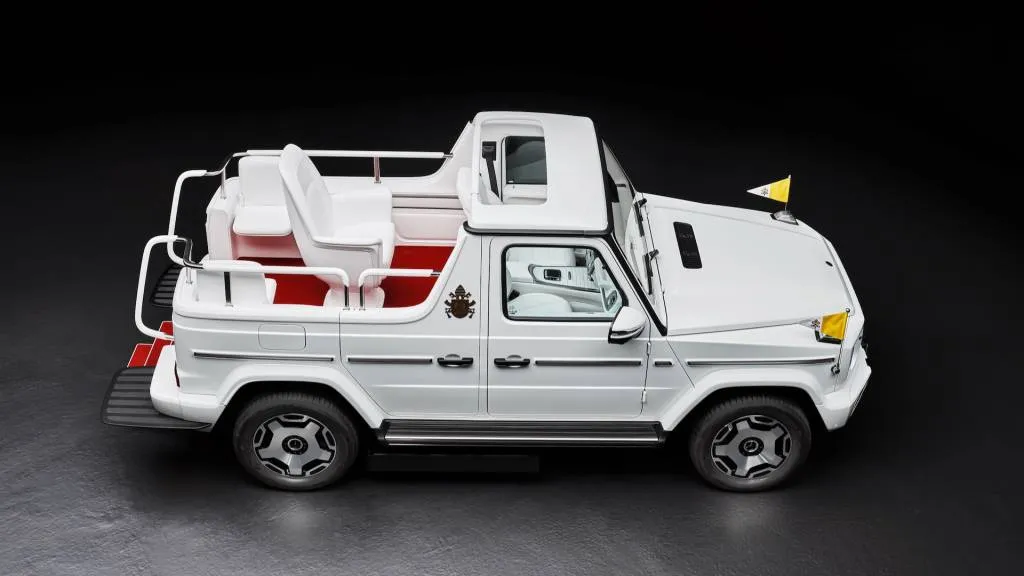
Mercedes-Benz G-Class electric Popemobile
That makes the electric G-Class’s designation as the first electric Popemobile historically apt, but it’s also the result of Fisker’s failure to deliver a Popemobile based on its Ocean electric SUV, something the now-bankrupt automaker proposed in 2021.
Mercedes was also slated to supply an M-Class (predecessor to today’s GLE-Class) plug-in hybrid Popemobile for Benedict XVI in 2011. At the time, the Vatican felt electric cars were too slow for this role, but that likely won’t be a concern with the modern G-Class EV.
The lay version of the electric G-Wagen has a quad-motor powertrain producing 579 hp and 859 lb-ft of torque, which Mercedes estimates will get it from 0-62 mph in 4.7 seconds and up to a top speed of 112 mph. The quad motors also enable a G-Turn feature that initiates 360-degre turns on low-friction surfaces, but it’s unclear if the Pope will make use of that feature.
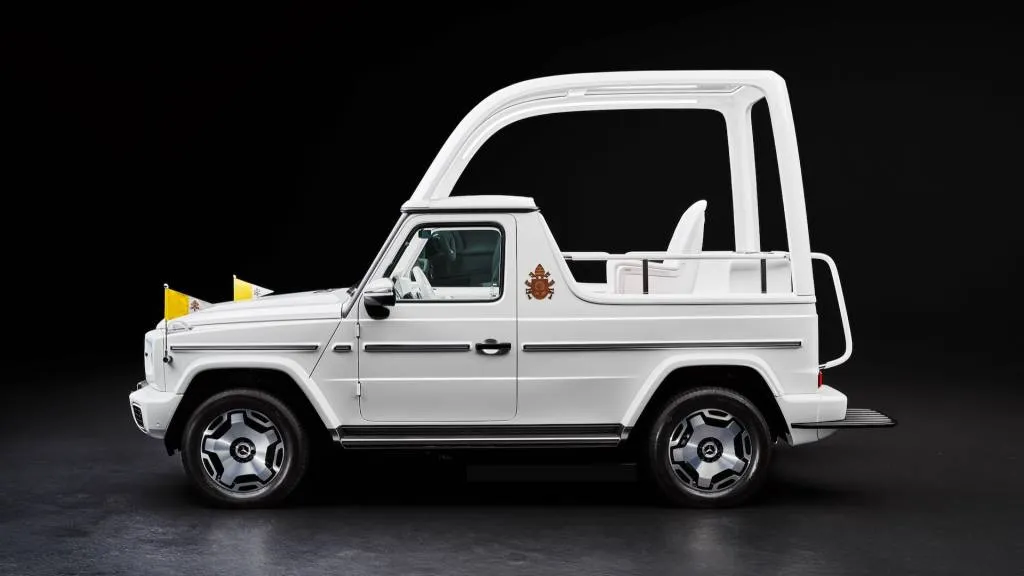
Mercedes-Benz G-Class electric Popemobile
The powertrain was retuned for low-speed driving during papal appearances, such as the 2025 Jubilee in Rome where the Popemobile will make its debut, according to Mercedes. The roof was also cut back to make room for an open seating area, with a cutout where the tailgate would normally be for ingress and egress. The left rear door was also removed, the right rear door given a reverse hinge to act as another entry point, and the vehicle was given a pearl white paint job with matching upholstery.
Sign up for Newsletter
While it is the first electric Popemobile, the G-Class is not the first EV in the Vatican fleet. General Motors presented Pope Francis with an Opel Ampera-e (the European sibling of the Chevrolet Bolt EV) in 2017, and Benedict XVI received a pair of electric cars from Renault in 2012. But the Mercedes will be the first to be used in an official capacity for public appearances.
2025 Lexus TX
 What kind of vehicle is the 2025 Lexus TX? What does it compare to? The Lexus TX is a three-row luxury crossover SUV. Compare it to the BMW X7, Volvo XC90, and Infiniti QX60. Is the 2025 Lexus TX a good SUV? It may be low on the excitement scale, but the 2025 Lexus TX is otherwise a well-conceived family-oriented three-row crossover SUV with good…
What kind of vehicle is the 2025 Lexus TX? What does it compare to? The Lexus TX is a three-row luxury crossover SUV. Compare it to the BMW X7, Volvo XC90, and Infiniti QX60. Is the 2025 Lexus TX a good SUV? It may be low on the excitement scale, but the 2025 Lexus TX is otherwise a well-conceived family-oriented three-row crossover SUV with good…
GM recalls 132,037 pickups due to faulty power tailgates
 General Motors is recalling 132,037 Chevrolet and GMC heavy-duty pickup trucks because their tailgates might open unexpectedly. The recall includes only models with power-unlatching tailgates, which contain an electronic gate-release switch that may short circuit from water intrusion, according to a NHTSA disclosure on Tuesday. This can cause the…
General Motors is recalling 132,037 Chevrolet and GMC heavy-duty pickup trucks because their tailgates might open unexpectedly. The recall includes only models with power-unlatching tailgates, which contain an electronic gate-release switch that may short circuit from water intrusion, according to a NHTSA disclosure on Tuesday. This can cause the…

Next-gen Lexus EV reportedly delayed
Lexus is delaying production of its next-generation electric flagship, reports Japanese media outlet NHK.
Previewed by the Lexus LF-ZL concept first seen at the 2023 Tokyo auto show, this model was originally slated to launch in 2026 but will now arrive in 2027, allowing time for more development work, according to the report.
The LF-ZL (short for “Lexus Future Zero-emission Luxury”) was an SUV measuring 208.6 inches long. That made it about eight inches longer than the Lexus LX, the brand’s largest SUV, and two inches longer than the LS sedan that has traditionally been the Lexus flagship.
Sign up for Newsletter
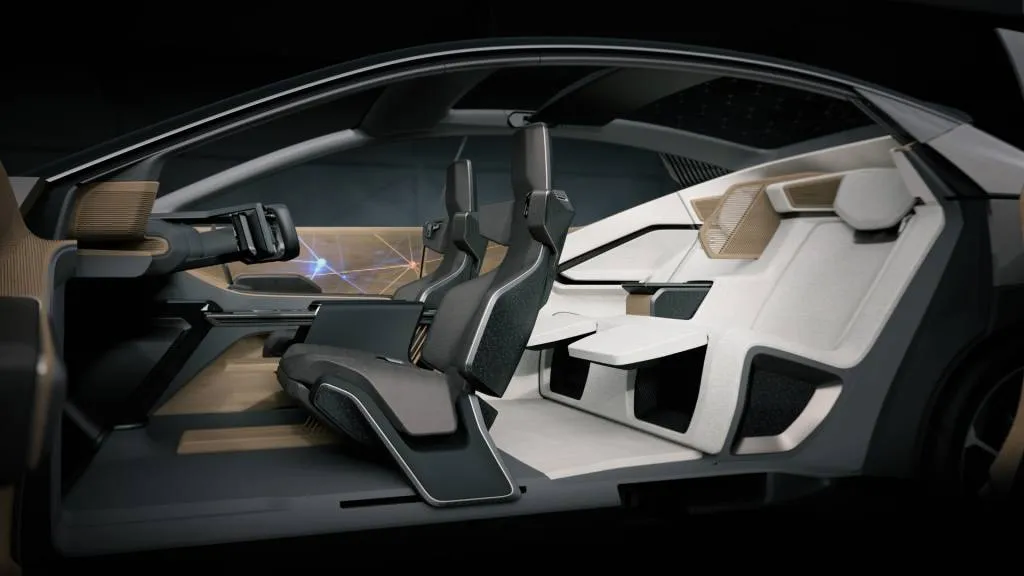
Lexus LF-ZL concept
Lexus said at the time of the concept’s unveiling that the LF-ZL was based on a dedicated EV platform, with a structure comprised of three large “gigacastings.” An engineering method advocated by Tesla, this replaces smaller welded components with large cast pieces, which Lexus has claimed will simplify manufacturing and increase structural rigidity.
The concept also featured prismatic battery cells, which Lexus said would allow for thinner battery packs and thus more design flexibility, and would also be used in future production EVs.
Lexus parent Toyota said last year that it intended to transform the luxury marque “into a battery EV brand” by 2035. In addition to the LF-ZL, the future EV lineup is expected to include a production version of the LF-ZC concept, a sleek hatch also unveiled at last year’s Tokyo show. These vehicles will be a big step forward from the Lexus RZ, the only Lexus EV currently sold in the U.S., and the electric version of the UX crossover sold in other markets.
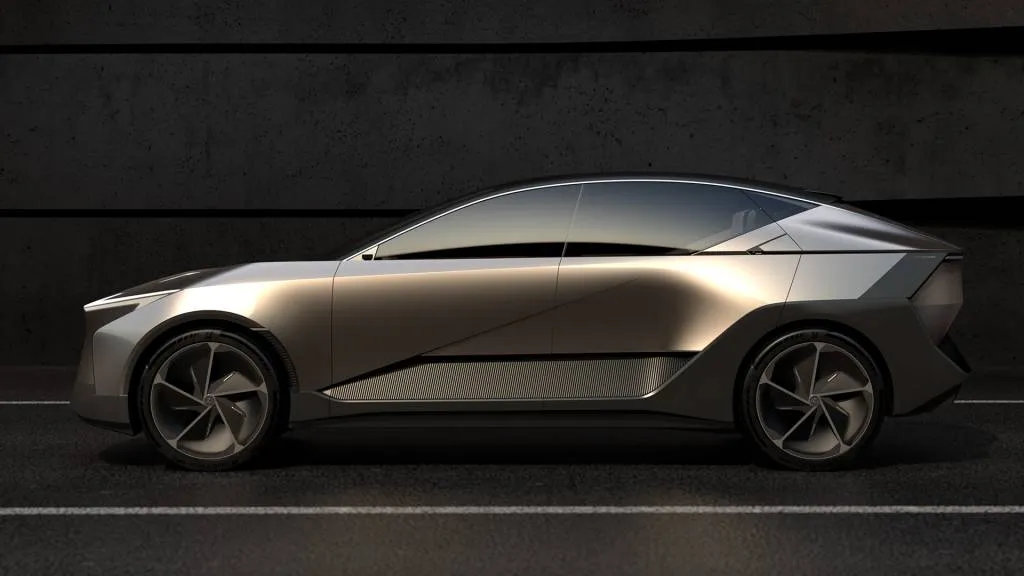
Lexus LF-ZL concept
Lexus has seemed on track to begin its electric transformation. In 2022, the brand’s engineering boss told Green Car Reports that an 800-volt electrical system for future EVs was ready, and a report earlier this year said Toyota was building a new battery plant for Lexus in Japan.
Toyota has itself walked back some of its EV plans, reportedly delaying the start of production of a new three-row electric SUV at a plant in Kentucky from 2025 to 2026. But the automaker has also said that, on a global scale, it will ramp up EV production to at least one million units in 2026. That represents a nearly tenfold increase from 2023 levels.




